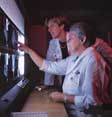 Defining what digital can do A new study underway at the cancer center will help determine whether digital mammography is better than standard film Reading a standard mammogram film is often a painstaking exercise that requires intense scrutiny of the smallest details. Radiologists must meticulously examine the film, which often looks murky white, to determine if there is something suspicious in the breast that could be cancer. This is no simple task. Sometimes what looks like cancer turns out to be nothing serious, or the mammogram fails to detect cancer. Some in the medical field are investigating if there is a better way. To this end, UC Davis and 18 other institutions are participating in a large clinical trial that will compare standard film-screen mammography with digital mammography for the detection of breast cancer. "Anything we can do to improve the sensitivity of mammography is going to save lives," said Karen Lindfors, professor of clinical radiology and lead investigator of the trial at UC Davis. "Currently, we don't detect 100 percent of breast cancers." The three-year trial, sponsored by the National Cancer Institute and the American College of Radiology Imaging Network, will enroll close to 50,000 women in the United States and Canada. The American Cancer Society and the NCI estimate breast cancer will claim more than 40,000 lives this year in the United States and that 180,000 women will be diagnosed with the disease. Digital mammography uses computers and specially designed detectors to produce a digital image of the breast, rather than a film image, that can be displayed on high-resolution computer monitors. Compression, or squeezing, of the breast is still required when digital mammography is performed.
Home |
Table of Contents |
To our Readers |
Building on Basics UC Davis Health System | © 2000, 2001, 2002 UC Regents. All rights reserved. |

 |
